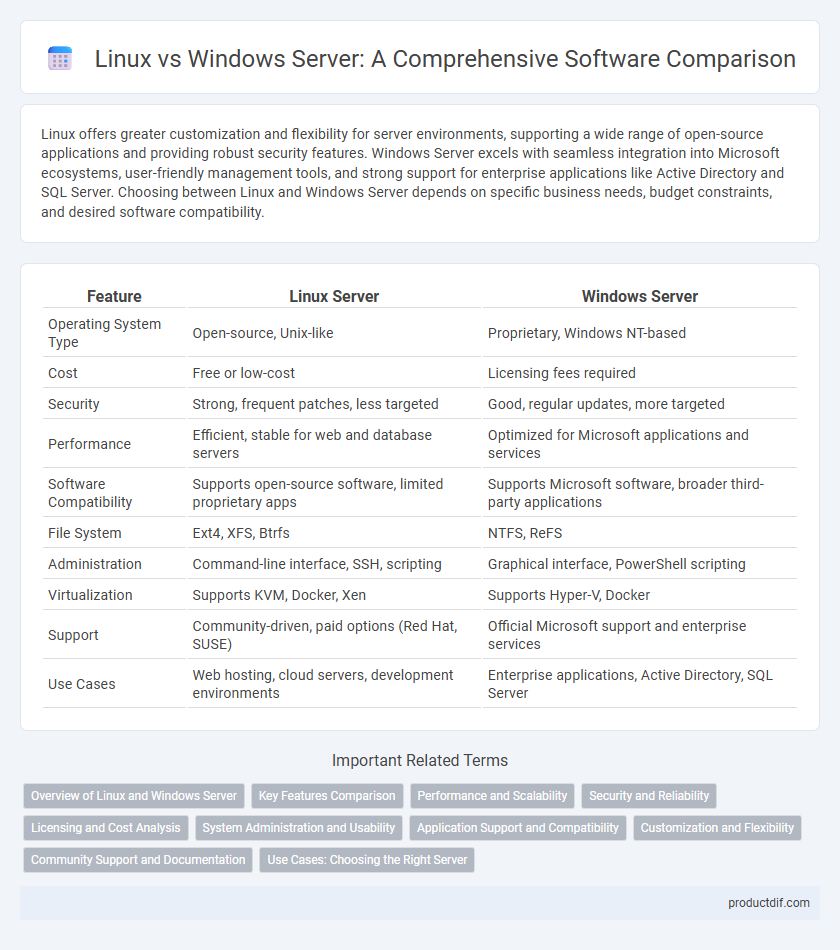Linux offers greater customization and flexibility for server environments, supporting a wide range of open-source applications and providing robust security features. Windows Server excels with seamless integration into Microsoft ecosystems, user-friendly management tools, and strong support for enterprise applications like Active Directory and SQL Server. Choosing between Linux and Windows Server depends on specific business needs, budget constraints, and desired software compatibility.
Table of Comparison
| Feature | Linux Server | Windows Server |
|---|---|---|
| Operating System Type | Open-source, Unix-like | Proprietary, Windows NT-based |
| Cost | Free or low-cost | Licensing fees required |
| Security | Strong, frequent patches, less targeted | Good, regular updates, more targeted |
| Performance | Efficient, stable for web and database servers | Optimized for Microsoft applications and services |
| Software Compatibility | Supports open-source software, limited proprietary apps | Supports Microsoft software, broader third-party applications |
| File System | Ext4, XFS, Btrfs | NTFS, ReFS |
| Administration | Command-line interface, SSH, scripting | Graphical interface, PowerShell scripting |
| Virtualization | Supports KVM, Docker, Xen | Supports Hyper-V, Docker |
| Support | Community-driven, paid options (Red Hat, SUSE) | Official Microsoft support and enterprise services |
| Use Cases | Web hosting, cloud servers, development environments | Enterprise applications, Active Directory, SQL Server |
Overview of Linux and Windows Server
Linux offers an open-source, customizable operating system favored for its stability, security, and extensive community support, making it ideal for web servers, cloud infrastructures, and development environments. Windows Server provides a proprietary platform with a user-friendly interface, seamless integration with Microsoft products, and robust support for enterprise applications, Active Directory, and virtualization technologies. Both systems excel in scalability and performance but cater to different administrative preferences and software ecosystems.
Key Features Comparison
Linux servers offer robust security features, extensive customization through open-source flexibility, and efficient performance for handling high-traffic web environments. Windows Server excels in seamless integration with Microsoft products, user-friendly graphical interface, and strong support for enterprise applications like Active Directory and Hyper-V virtualization. Both platforms provide reliable networking capabilities and scalability options, making the choice dependent on organizational needs and technical expertise.
Performance and Scalability
Linux servers offer superior performance and scalability due to their lightweight kernel and efficient resource management, making them ideal for high-demand environments. Windows Server delivers robust integration with Microsoft ecosystems but can consume more system resources, potentially limiting scalability in large-scale deployments. Benchmark tests consistently show Linux outperforming Windows Server in handling concurrent processes and scaling horizontally across distributed systems.
Security and Reliability
Linux servers offer enhanced security through open-source transparency, allowing rapid vulnerability detection and patching by a global community, which reduces the risk of malware and unauthorized access. Windows Server provides robust security features like Active Directory integration and advanced threat protection, but its proprietary nature can delay response times to newly discovered exploits. In terms of reliability, Linux servers are favored for their stability and uptime in critical environments, while Windows Server benefits from strong support and seamless integration with enterprise applications.
Licensing and Cost Analysis
Linux offers open-source licensing with no initial software cost, allowing organizations to deploy servers without paying licensing fees. Windows Server requires purchasing per-core or per-user licenses, leading to higher upfront and ongoing expenses. Total cost of ownership for Linux remains lower due to eliminated license fees and community-supported updates, making it a cost-effective choice for scalable server environments.
System Administration and Usability
Linux offers advanced system administration features with extensive command-line tools and customizable scripting environments, enhancing automation and control for experienced administrators. Windows Server provides a user-friendly graphical interface and integrated management consoles, simplifying routine tasks for administrators with less command-line expertise. Both systems support robust security protocols and remote management capabilities, but Linux's open-source nature allows for greater flexibility and customization in enterprise environments.
Application Support and Compatibility
Linux offers extensive application support for open-source software, development tools, and containerization platforms like Docker and Kubernetes, making it ideal for cloud-native applications. Windows Server excels in compatibility with enterprise applications, especially those built on .NET framework, Microsoft SQL Server, and Active Directory services. Both platforms support virtualization, but Windows Server has broader support for legacy Windows applications and proprietary software ecosystems.
Customization and Flexibility
Linux offers superior customization and flexibility due to its open-source nature, allowing administrators to tailor the operating system at the kernel and application levels. Windows Server provides a more standardized environment with graphical user interfaces and built-in tools, but its customization options are limited compared to Linux. For enterprise environments requiring highly specific configurations, Linux delivers greater adaptability through extensive scripting and modular software components.
Community Support and Documentation
Linux offers extensive community support and comprehensive, open-source documentation maintained by a global network of developers, enabling rapid troubleshooting and continuous updates. Windows Server provides robust official documentation and dedicated Microsoft support channels, supported by a large ecosystem of certified professionals and enterprise resources. The active Linux forums and community-driven platforms often deliver faster, peer-based assistance compared to proprietary Windows Server support structures.
Use Cases: Choosing the Right Server
Linux servers excel in open-source environments, web hosting, and development platforms requiring flexibility and customization, supporting diverse distributions like Ubuntu, CentOS, and Debian tailored for scalability and security. Windows Server is ideal for enterprise environments dependent on Microsoft applications, Active Directory, and seamless integration with Windows-based networks, offering robust support for .NET frameworks and Hyper-V virtualization. Evaluating specific workload demands, such as database management, cloud compatibility, or virtualization needs, guides the selection between Linux or Windows Server to optimize performance and cost-efficiency.
Linux vs Windows Server Infographic

 productdif.com
productdif.com